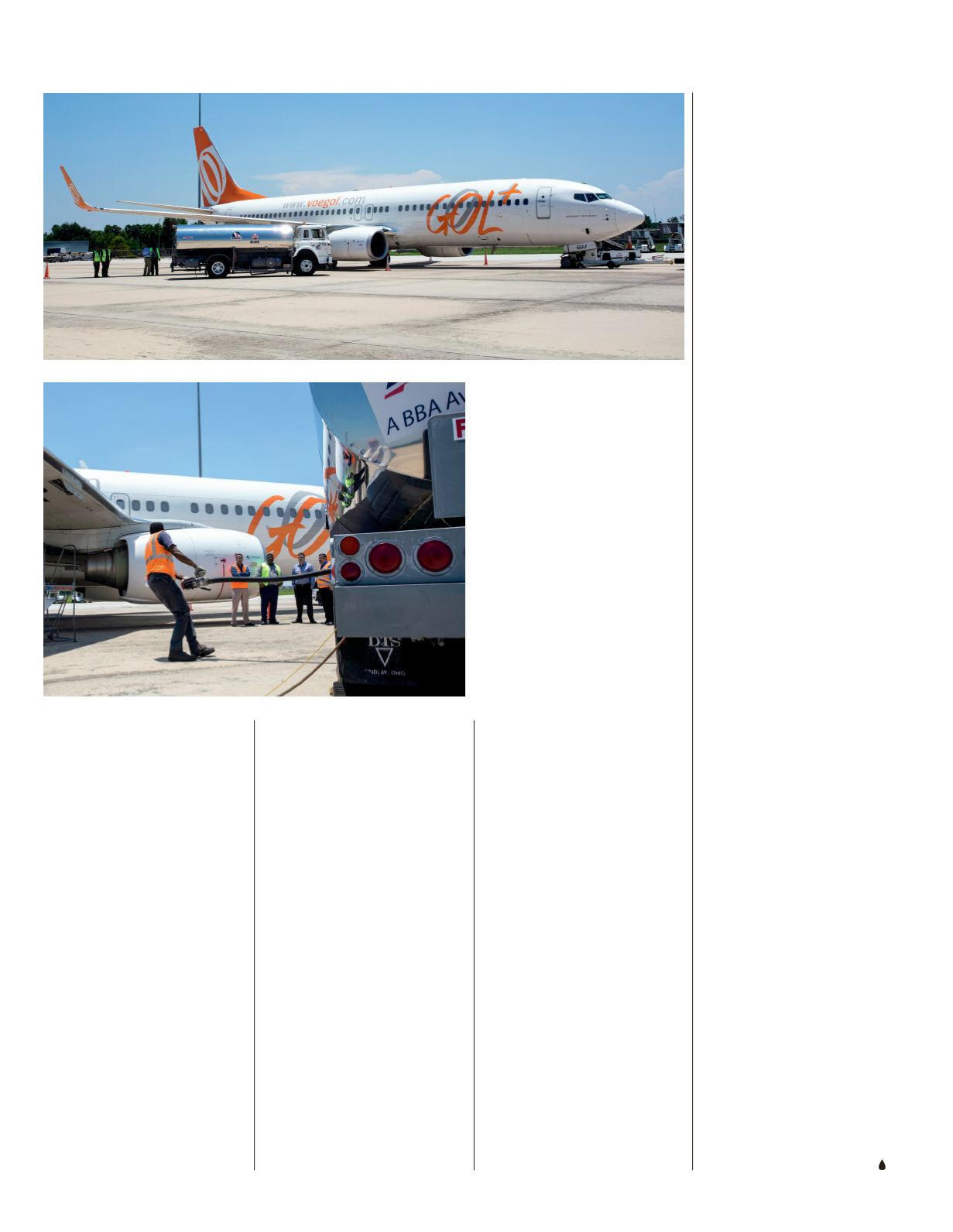
FUELS & LUBES INTERNATIONAL
Quarter Four 2014
18
The DSHC route was ASTM
certified in June 2014 when ASTM
D7566 was revised to include the
use of farnesane in blends of up to
10% for commercial use.
The process for making
farnesane, which is a C15 isoparaffin,
uses sugar as a feedstock. The
steps involve fermentation and
hydrogenation/distillation, turning
farnesene into farnesane. So far
only a plant in Brazil conducts the
fermentation step; the second step
can be carried out at other Amyris/
Total locations.
Mostly sugar cane is currently
used as a feedstock, but Amyris
and Total have demonstrated that
other sugars, such as cellulosic
sugars, can be used. The hope is for
them to move towards second-
generation sugar as they, not
interfering with food supply, are
truly sustainable.
Amyris/Total’s fuel has
some superior qualities over
hydrocarbon fuels, said Amyris/
Total Alliance Manager, Olivier
Rolland. It has significantly higher
energy content and a freezing
point below -100˚C. Additionally,
it is highly thermally stable, he
said. Thermostability is as high as
385˚C compared to 325˚C for fuel
produced with HEFA and 260˚C
for conventional jet fuel.
According to Fernando García,
senior director of scientific and
regulatory affairs at Amyris,
Lufthansa recently tested one of
Amyris’ 10% blends and found
that particulate output decreased
by 3%. Lufthansa conducted this
test with a spread of Jet A-1 fuels,
representing what would actually
be used in flights in Western
Europe.
It took about two years, a
relatively short time, to get ASTM
certification. Once Amyris/Total
produced an aviation grade of
farnesane that is representative
of large-scale production, they
blended the molecule at 10, 20 and
50%, seeing that all blends met
D7566.
Following this was a fit-for-
purpose test to “explore deeply
each physical and performance
property that is important for
aviation,” Rolland said. The fit-
for-purpose test only used blends
of 10 and 20% and was mostly
conducted and funded by the U.S.
Air Force. They also conducted
a material compatibility test,
working with OEMs, and finally
engine tests, taking the engine
to critical regimes. Each time
they found that farnesane did not
negatively impact the engine’s
performance. Engine tests were
performed at Saffron, Lufthansa,
Honeywell and Pratt & Whitney.
Although the tests were
conducted at blends up to 50%,
the standard only allows for a 10%
blend. Other alternative jet fuels
are blended at higher percentages;
HEFA fuels are usually blended at
50% or more. A 10% blend leaves
a large safety margin and is made
for more optimal testing during the
certification process, Rolland said.
Most companies also use a range
in carbon distribution, from C9 to
C15, and the Amyris/Total route
only uses one, C15. According to
Rolland, other industry players saw
this as a “yellow flag,” as a single
molecule had never been used
before. Starting with a 10% blend
demonstrated to the market that
the single molecule concept works.
Quantities of the product are
still limited with only one facility
in Brazil producing farnesane.
Nonetheless, “the willingness to
make this fuel available wherever
it is needed,” is there, Rolland said.
At this point, he said, the focus
is on building relationships with
airlines, which can be potential
customers.
The joint venture has started
down that road. Since the
ASTM certification, there was
a commercial flight with the
Brazilian airline, GOL, from
Orlando, Fla., USA, to Sao Paolo,
Brazil, using a 10% blend of the
sugarcane-derived fuel.
One reason prices of renewable
jet fuel are not competitive with
hydrocarbon-based jet fuel is that
their feedstocks, especially the
second-generation ones used to
make HEFA blends, are not cheap
enough to produce on a large scale.
Rolland said that the technology
used to transform the feedstocks
is also expensive. The process is
made more expensive by the more
stringent specifications in the
alternative jet fuel standard, as
opposed to conventional jet fuel.
In particular, metal contaminants
are especially low in the alternative
jet fuel specification.
However, in light of the airline
industry’s goal of carbon neutral
growth from 2020, which was
announced by the International
Air Travel Association (IATA) in
2009, it is projected that biofuel
use will rise, and hopefully that
will bring down the cost over time.
Several other processes for
making aviation biofuels are being
considered. For the industry to
reach its goal of carbon-neutral
growth, it is necessary to make
more fuel-efficient airplanes and to
use biofuels or biofuel blends.
The DSHC
route was
ASTM certified
in June 2014
when ASTM
D7566 was
revised to in-
clude the use
of farnesane
in blends of
up to 10% for
commercial
use.


